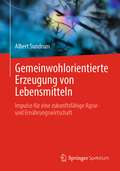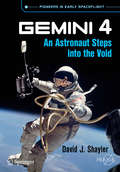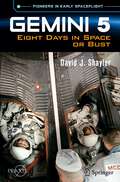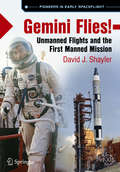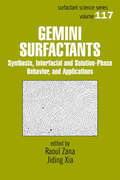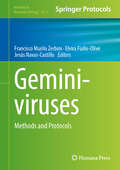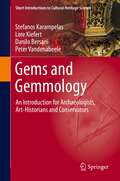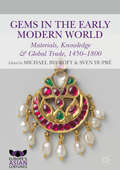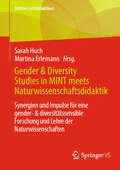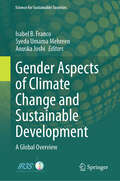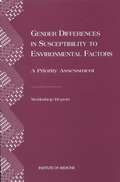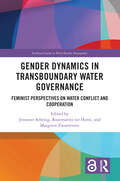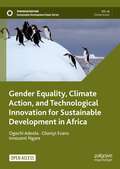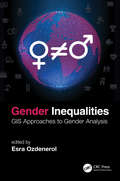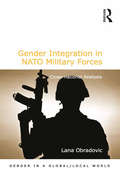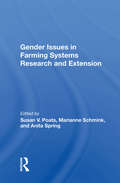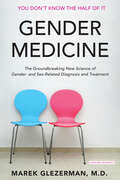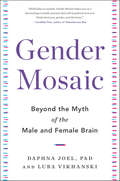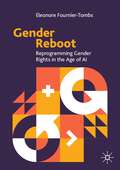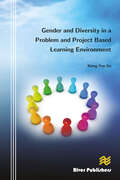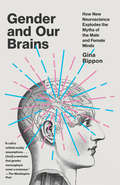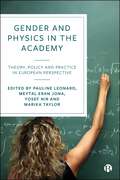- Table View
- List View
Gemeinwohlorientierte Erzeugung von Lebensmitteln: Impulse für eine zukunftsfähige Agrar- und Ernährungswirtschaft
by Albert SundrumLebensmittel sind Mittel zum Leben. Die Art und Weise ihrer Erzeugung betrifft uns alle. Weitgehend unbemerkt von der öffentlichen Wahrnehmung hat sich in den vergangenen Jahrzehnten ein System der Agrar- und Ernährungsindustrie entwickelt, das uns mit einer Fülle von Nahrungsmitteln mit zu niedrigen Preisen versorgt.Die unerwünschten Nebenwirkungen und externen Kosten dieses Systems wurden jedoch lange Zeit ausgeblendet. Enorme Umwelt- und Klimabelastungen, Verlust der Biodiversität, tierschutzrelevante Missstände und ein anhaltendes Hofsterben beschreiben nur unzulänglich das wahre Ausmaß an Schadwirkungen. Im Interesse des Gemeinwohls können diese nicht länger hingenommen werden. Allerdings stehen die Komplexität der Sachverhalte und vielfältige Partikularinteressen einfachen Lösungen entgegen.Dieses Fachbuch liefert eine umfassende systemische Analyse aus sehr unterschiedlichen Perspektiven und erläutert, wie es zu dieser Entwicklung hat kommen können. Es wird aufgezeigt, welche grundlegenden Veränderungen in allen Bereichen erforderlich sind, um über eine evidenzbasierte Qualitätserzeugung einen Ausweg aus dem zerstörerischen Streben nach Kostenminimierung zu finden. Fachkräfte der Agrar- und Ernährungsindustrie und der involvierten wissenschaftlichen Fachdisziplinen, einschließlich der Veterinärmedizin, sowie Entscheidungsträger in politischen Institutionen, Berufsverbänden und NGOs können dieses Wissen für eine zukunftsfähige Neugestaltung des Lebensmittelsektors nutzen.
Gemini 4: An Astronaut Steps Into The Void (Springer Praxis Books)
by David J. ShaylerThe flight of Gemini 4 in June 1965 was conducted barely four years after the first Americans flew in space. It was a bold step by NASA to accomplish the first American spacewalk and to extend the U.S. flight duration record to four days. This would be double the experience gained from the six Mercury missions combined.This daring mission was the first to be directed from the new Mission Control at the Manned Spacecraft Center near Houston, Texas. It also revealed that: Working outside the spacecraft would require further study.Developing the techniques to rendezvous with another object in space would not be as straightforward as NASA had hoped.Living in a small spacecraft for several days was a challenging but necessary step in the quest for even longer flights.Despite the risks, the gamble that astronauts Jim McDivitt and Ed White undertook paid off. Gemini 4 gave NASA the confidence to attempt an even longer flight the next time. That next mission would simulate the planned eight-day duration of an Apollo lunar voyage. Its story is recounted in the next title in this series: Gemini 5: Eight Days in Space or Bust.
Gemini 5: Eight Days in Space or Bust (Springer Praxis Books)
by David J. ShaylerThis third book of the Gemini mission series focuses on the flight that simulated in Earth orbit the duration of an eight-day Apollo mission to the Moon. After the proof-of-concept test flights Gemini 1, 2 and 3 (as described in GEMINI FLIES!) and the success of the first American EVA as well as the four-day U.S. mission (GEMINI 4), NASA gained the confidence to gradually increase mission time spent in orbit. This is the first known book to focus solely on the Gemini 5 mission and its challenges with equipment failures and difficult living conditions. The mission was targeted to double the endurance of the previous one, and as such was an integral stepping stone for an even more audacious mission four months later. Attempting the eight- and then fourteen-day durations would be an opportunity for America to gain the lead in space exploration over the Soviets. This mission pioneered the duration of a flight to the Moon and back three years before Apollo 8 made that journey, without a lunar landing, for the first time.
Gemini Flies!
by David J. ShaylerIn May 1961, President John F. Kennedy committed the United States to landing a man on the moon before the end of the decade. With just a handful of years to pull it off, NASA authorized the Project Gemini space program, which gathered vital knowledge needed to achieve the nation’s goal. This book introduces the crucial three-step test program employed by the Gemini system, covering: The short unmanned orbital flight of Gemini 1 that tested the compatibility of launch vehicle, spacecraft and ground systems. The unmanned suborbital flight of Gemini 2 to establish the integrity of the reentry system and protective heat shield. The three-orbit manned evaluation flight of Gemini 3, christened ‘Molly Brown’ by her crew. A mission recalled orbit by orbit, using mission transcripts, post-flight reports and the astronauts’ own account of their historic journey.The missions of Project Gemini was the pivotal steppingstone between Project Mercury and the Apollo Program. Following the success of its first two unmanned missions and the exploits of Gus Grissom and John Young on Gemini 3, NASA gained the confidence to plan an even bolder step on its next mission, as described in the next book in this series on Gemini 4.
Gemini Surfactants: Synthesis, Interfacial and Solution-Phase Behavior, and Applications (Surfactant Science)
by Raoul Zana Jiding XiaGenerating much interest in both academic and scientific circles, Gemini Surfactants gathers the most up-to-date research in gemini surfactantproduction and demonstrates how their propertiesand performance can revolutionize the current industrial application of these surfactants. It surveys the state of special gemini surfactants, inc
Geminiviruses: Impact, Challenges and Approaches
by R. Vinoth KumarThis book provides in-depth information on all key aspects of geminivirus biology, e.g. the genetics and evolution, global diversity and spread of these plant pathogens, as well as the molecular mechanisms underlying their virulence. Geminiviridae is one of the largest viral families, comprising numerous plant-infecting viruses that cause diseases in crops and weeds. These diseases have been reported from nearly all continents, in particular Asia, Europe, Africa and America. The book summarizes the current state of knowledge on the interactions between plant host and virus. In addition, it discusses advances regarding the trans-replication of satellite molecules and its effect on geminiviral pathogenesis, as well as pest management strategies to combat these diseases in the field. Given its scope, the book is a must-read reference guide for all researchers and advanced students working in virology, agriculture and plant biotechnology..
Geminiviruses: Methods and Protocols (Methods in Molecular Biology #2912)
by Francisco Murilo Zerbini Elvira Fiallo-Olivé Jesús Navas-CastilloThis book provides a comprehensive list of the methods used in basic and applied geminivirus research. Chapters guide readers through foundational methods, advanced techniques in cloning, sequencing, phylogenetic, recombination analysis, diagnostics, and virus-host interaction studies. Written in the format of the highly successful Methods in Molecular Biology series, each chapter includes an introduction to the topic, lists necessary materials and reagents, includes tips on troubleshooting and known pitfalls, and step-by-step, readily reproducible protocols. Authoritative and cutting-edge, Geminiviruses: Methods and Protocols aims to be a practical laboratory guide and serve as a valuable "one-stop-shop" for researchers new to geminiviruses, facilitating the establishment of a robust geminivirus research program.
Gems and Gemmology: An Introduction for Archaeologists, Art-Historians and Conservators (Short Introductions to Cultural Heritage Science)
by Peter Vandenabeele Stefanos Karampelas Lore Kiefert Danilo BersaniThis book provides a lucid introduction to the basics of gemmology. It familiarizes archaeologists, art historians and conservators with the science of gemstones and allows them to understand the basic concepts of their provenance, typology and treatments.Which are the main types of gems? What treatments can be applied? How does one analyse gems? How can gems contribute to archaeometrical research?This volume is written by four experts in the fields of gemmology and archaeometry and addresses both students who need an introduction to this field and professionals who want to refresh their knowledge of the topic. This work is part of a series of introductory texts that deal with a broad range of materials-related topics in archaeometry.
Gems in the Early Modern World: Materials, Knowledge and Global Trade, 1450–1800 (Europe's Asian Centuries)
by Sven Dupré Michael BycroftThis edited collection is an interdisciplinary study of gems in the early modern world. It examines the relations between the art, science, and technology of gems, and it does so against the backdrop of an expanding global trade in gems. The eleven chapters are organised into three parts. The first part sets the scene by describing how gems moved around the early modern world, how they were set in motion, and how they were pulled together in the course of their travels. The second part is about value. It asks why people valued gems, how they determined the value of a given gem, and how the value of a gem was connected to its perceived place of origin. The third part deals with the skills involved in cutting, polishing, and mounting gems, and how these skills were transmitted and articulated by artisans. The common themes of all these chapters are materials, knowledge and global trade. The contributors to this volume focus on the material properties of gems such as their weight and hardness, on the knowledge involved in exchanging them and valuing them, and on the cultural consequences of the expanding trade in gems in Eurasia and the Americas.
Gen- und Zelltherapie 2.023 - Forschung, klinische Anwendung und Gesellschaft: AG Gentechnologiebericht mit freundlicher Unterstützung der DG-GT und des GSCN
by Hannah Schickl Boris Fehse Sina Bartfeld Martin ZenkeWenn Sie sich für den Stand der Dinge auf dem Gebiet der Gen- und Zelltherapie interessieren, bietet Ihnen diese Open-Access-Publikation einen umfassenden und hochaktuellen Überblick.Wissenschaftler und Experten behandeln Fragen wie: Haben CAR-T-Zellen etwas mit Autos zu tun, wie funktionieren Genfähren, können uns Stammzellen bei Therapien helfen, was sind Organoide und warum dauert es oft so lange, bis neuartige Behandlungskonzepte in die Klinik kommen? Kann man Gene wie Bücher editieren, wie gefährlich ist das eigentlich und wer kontrolliert sowas, muss Gentherapie so teuer sein und ist sichergestellt, dass alle Patienten die Therapie bekommen, die sie benötigen?
Gender & Diversity Studies in MINT meets Naturwissenschaftsdidaktik: Synergien und Impulse für eine gender- & diversitätssensible Forschung und Lehre der Naturwissenschaften (Edition Fachdidaktiken)
by Martina Erlemann Sarah HuchGender und dessen Zusammenwirken mit weiteren Diversity-Dimensionen wie etwa soziale Herkunft, ein (zugeschriebener) Migrationshintergrund oder sexuelle Orientierung stehen an Hochschulen verstärkt im Fokus. Gefordert sind dabei auch gender- und diversitysensible Ausrichtungen der Forschung und Lehre der MINT-Fächer sowie der hochschulischen Lehramtsausbildung für MINT. Welche inhaltliche Relevanz haben Gender- und Diversity-Aspekte in Fachkultur, Forschungsinhalten sowie im Wissenschaftsverständnis der Naturwissenschaften? Wie strukturieren Geschlecht und andere soziale Differenzkategorien die Forschung? Wie kann eine Gender- und Diversity-Kompetenzen vermittelnde Lehrer*innenbildung aussehen?Auf diese Fragen geben die interdisziplinären Beiträge der Wissenschaftler*innen, etwa aus Physik, Biologie, Medizin, Feminist Science & Technology Studies sowie die naturwissenschaftlichen Fachdidaktiken Antworten. Ansätze sowie Wissensbestände der Gender & Diversity Studies in MINT werden mit den gender- und diversityausgerichteten Naturwissenschaftsdidaktiken zusammengeführt. Mit vielfältigen Anregungen ermutigen sie zu einer gender- und diversityorientierten Ausrichtung der (eigenen) Forschung und Lehre.
Gender Aspects of Climate Change and Sustainable Development: A Global Overview (Science for Sustainable Societies)
by Isabel B. Franco Syeda Umama Mehreen Anuska JoshiThis book addresses how sustainability discourse and advocacy can translate to impactful policies especially when bridging the divide between sustainability, climate change and gender. The book explores various areas, such as conservation, climate action, sustainable fashion, and corporate sustainability, and defines the existing sustainability gaps in the selected cases (country/sector/region). It highlights the value of sustainability science and climate change on innovative approaches to research, education, capacity-building, and practice to transform rhetoric into impact sustainability while encompassing cases from various industries, sectors, and geographical contexts. While emphasizing SDG 5, the book chapters also show the transboundary implications of gender equality and inclusivity to other sustainable development and climate change goals and targets. The contributions are exemplary in highlighting the relation of gender inclusivity in strengthening efforts to protect andsafeguard the world’s cultural and natural heritage and making cities and human settlements inclusive and safe (Goal 11), protecting, restoring, and promoting sustainable management of terrestrial ecosystems and reverse land degradation (Goal 15), ensuring access to affordable, reliable, sustainable and modern energy for all (Goal 7), promoting sustainable and inclusive economic growth with productive and decent employment for all (Goal 8), promoting inclusive and sustainable industrialization (Goal 9), adopt policies to reduce inequalities (Goal 10), ensure sustainable consumption and production pattern (Goal 12), addressing climate change impacts and building resilience (Goal 13), and ensuring availability and sustainable management of water and sanitation for all (Goal 6).
Gender Differences in Susceptibility to Environmental Factors: Workshop Report
by Committee on Gender Differences in Susceptibility to Environmental FactorsWomen's health and men's health differ in a variety of ways--women live longer on average, for example, but tend to be sicker as well. Whereas some of these distinctions are based solely on gender, there is growing awareness that the environment and related factors may play a role in creating health status differences between men and women. Various factors, such as genetics and hormones, may account for gender differences in susceptibility to environmental factors.In 1996 the Office for Research on Women's Health at the National Institutes of Health asked the Institute of Medicine to conduct a workshop study to review some of the current federal research programs devoted to women's health and to clarify the state of knowledge regarding gender-related differences in susceptibility. This book contains a general outline of research needs, a summary of the workshop proceedings (as well as summaries of the speakers' presentations), and an analysis of the participating federal agencies' research portfolios.
Gender Dynamics in Transboundary Water Governance: Feminist Perspectives on Water Conflict and Cooperation (Earthscan Studies in Water Resource Management)
by Jenniver Sehring Rozemarijn ter Horst and Margreet ZwarteveenThis volume assesses the nexus of gender and transboundary water governance, containing empirical case studies, discourse analyses, practitioners’ accounts, and theoretical reflections. Transboundary water governance exists at the intersection of two highly masculinised fields: diplomacy and water resources management. In both fields, positions are mainly held by men, and core ideas, norms, and guiding principles that are presented as neutral, are both shaped by men and based on male experiences. This book sheds light on the often hidden gender dynamics of water conflict and cooperation at the transboundary level and on the implicit assumptions that guide research and policies. The individual chapters of the book, based on case studies from around the world, reveal the gendered nature of water diplomacy, take stock of the number of women involved in organisations that govern shared waters, and analyse programmes that have been set up to promote women in water diplomacy and the obstacles that they face. They explore and contest leading narratives and knowledge that have been shaped mainly by privileged men, and assess how the participation of women concretely impacts the practices, routines, and processes of water negotiations. This volume will be of great interest to students and scholars of water governance, water diplomacy, gender, international relations and environmental politics. It will also be of interest to professionals and policymakers involved in supporting gender mainstreaming in water cooperation.
Gender Equality, Climate Action, and Technological Innovation for Sustainable Development in Africa (Sustainable Development Goals Series)
by Ogechi Adeola Olaniyi Evans Innocent NgareThis open access book explores the intersection of gender and climate change, suggests ways in which innovative technologies can accelerate climate relief actions, and offers strategies for integrating climate change initiatives into national policies and planning. By examining the devastating consequences of climate change on women and girls throughout the continent, the authors pose a crucial question: Does gender matter in climate change discussions in Africa? Political and social traditions have burdened women with greater vulnerability to the impacts of climate-related natural disasters, including violence, displacement, poverty, famine and lack of access to clean water. However, women are also key to effective and inclusive climate mitigation, adaptation, and decision-making. The authors provide a compelling discourse that identifi es the social and economic benefi ts for all citizens when genderinclusive policies shape equitable and targeted action plans, from mitigationto adaptation and funding.The UN’s SDG 13 calls for urgent action and commitment to combat climate change. The implementable and action-oriented propositions presented in this book will be of interest to students, educators, practitioners, third-sector actors, and policymakers committed to gender equality, sustainable development and climate action in Africa.
Gender Inequalities: GIS Approaches to Gender Analysis
by Esra OzdenerolGender inequality is entrenched in the cultural, political, and market systems that operate at household, community, and national levels. Overarching global changes in access to markets, climatic conditions, and the availability of natural resources intensify disparities in income, assets, and power among genders. This book explains these gender dynamics at macro and micro levels through GIS and spatial analysis. Chapter 1 provides an overview of the current role of GIS in the context of gender inequalities, how it still exists globally despite substantial national and international measures that have been taken toward gender equality. It illustrates global and country-level maps of measures of gender inequalities, such as gender equality index, access to basic education, health and life expectancy, equality of economic opportunity, and political empowerment. The global case studies provided in the consequent chapters explore the world of gender inequalities and get directly involved with some of the GIS and mapping applications. Chapter 2 investigates how GIS can be adapted for the criminal justice response to domestic violence (DV) and to eliminate gender-based violence. Chapter 3 discusses applying GIS and spatial analysis to the prevalence and incidence mapping of intimate partner violence (IPV) and geospatial factors that influence help-seeking and resource availability. Chapter 4 discusses the spatial disparity of gender-representation across industry types in the United States. Chapter 5 explores the social and environmental injustice experienced by female migrant workers at Guiyu town, China, in the context of both environmental pollution and governance. Chapter 6 presents a social vulnerability index to identify spatial patterns of social vulnerability and gender inequalities among Mexican households. Chapter 7 presents the United States’ opioid crisis over the past two decades and analysis of mortality by gender, race, age, and urbanicity. Chapter 8 discusses the commitment to "leave no one behind" as the heart of the 2030 Agenda for Sustainable Development and identifies inequalities among women and girls by mapping multiple deprivations in Pakistan. Chapter 9 discusses the long-standing challenges in establishing gender parity in the transportation workforce in the United States. Chapter 10 presents a study that utilizes geospatial statistical tools and state-level admission data to examine gender inequalities in higher-education enrollment in Nigeria and investigates the key factors on enrollment. This book fosters engagement with the newest mapping and GIS application in contemporary issues regarding gender inequalities and nurtures recognition of how institutional global, everyday, and intimate spaces are inherently gendered, classed, raced, and sexualized. It demonstrates the spatiality of the politics of gender difference, and the contributions of GIS and spatial analysis to the struggles for equality and social justice. A unique work that Lays out a step-by-step approach to identify relevant GIS applications, spatial methods, data collection, and mapping techniques for gender inequalities research Has a strong international and global perspective. The author is well-informed in global perspectives Investigates the patterns/processes and indicators driving gender inequality at various temporal scales and at comparably detailed resolutions Illustrates finer-scale case studies, appropriate for local programs and interventions, as well as global scale studies contributing to international and national-level policy discussions on gender inequality Since gender inequality is a research area that is very wide and with strands into many academic traditions, this book is aimed at different and diverse academics/research. It is written for geographers, public health practitioners, sociologists, epidemiologists, criminologists, politicians, economists, environmentalists, G
Gender Integration in NATO Military Forces: Cross-national Analysis (Gender in a Global/Local World)
by Lana ObradovicNumerous states have passed gender integration legislation permanently admitting women into their military forces. As a result, states have dramatically increased women’s numbers, and improved gender equality by removing a number of restrictions. Yet despite changes and initiatives on both domestic and international levels to integrate gender perspectives into the military, not all states have improved to the same extent. Some have successfully promoted gender integration in the ranks by erasing all forms of discrimination, but others continue to impede it by setting limitations on equal access to careers, combat, and ranks. Why do states abandon their policies of exclusion and promote gender integration in a way that women’s military participation becomes an integral part of military force? By examining twenty-four NATO member states, this book argues that civilian policymakers and military leadership no longer surrender to parochial gendered division of the roles, but rather support integration to meet the recruitment numbers due to military modernization, professionalization and technological advancements. Moreover, it proposes that increased pressure by the United Nations to integrate gender into security and NATO seeking standardization and consistency on the international level, and women’s movements on the domestic level, are contributing to greater gender integration in the military.
Gender Issues In Farming Systems Research And Extension
by Marianne Schmink Susan V. Poats Anita SpringThis book is the product of an international conference hosted by the Women in Agricultural Development (WIAD) Program at the University of Florida in 1986. The purpose of WIAD program is to promote an understanding of gender and its relevance for agricultural development processes.
Gender Medicine: The Groundbreaking New Science of Gender- and Sex-Related Diagnosis and Treatment
by Marek GlezermanAn exploration of how to bring medicine into the twenty-first century with our understanding of gender and sex differences. Over millions of years, male and female bodies developed crucial physiological differences to improve the chances for human survival. These differences have become culturally obsolete with the overturning of traditional gender roles. But they are nevertheless very real, and they go well beyond the obvious sexual and reproductive variances: men and women differ in terms of digestion, which affects the way medications are absorbed. Sensitivity to pain is dependent on gender. Even the symptoms of a heart attack manifest differently in a man than in a woman. And yet the medical establishment largely treats male and female patients as though their needs are identical. In fact, medical research is still done predominately on men, and the results are then applied to the treatment of women. This is clearly problematic and calls for a paradigm change—such a paradigm change is the purpose of Gender Medicine.Praise for Gender Medicine &“Gender Medicine is cutting edge in that the author challenges the historical and antiquated paradigms that women and men are interchangeable with respect to their physiology, pharmacology and pathophysiology excluding their reproductive organs. There is a shocking paucity of resource material showcasing the most current and complete evidence on sex and gender-based medicine. Marek Glezerman&’s book is a comprehensive and pleasurable read; it will enlighten both medical and nonmedical audiences and is highly applicable to the effective clinical practice of medicine in the twenty-first century.&” —Alyson J. McGregor M.D., MA, FACEP, Director, Division of Sex and Gender in Emergency Medicine (SGEM), Warren Alpert Medical School of Brown Universit &“This fascinating work will teach readers a great deal about sex, gender, and the human body. A must-read for health-care practitioners and anyone interested in medicine.&” —Library Journal, starred review
Gender Mosaic: Beyond the Myth of the Male and Female Brain
by Luba Vikhanski Daphna Joel,With profound implications for our most foundational assumptions about gender, Gender Mosaic explains why there is no such thing as a male or female brain.For generations, we've been taught that women and men differ in profound and important ways. Women are more sensitive and emotional, whereas men are more aggressive and sexual, because this or that region in the brains of women is smaller or larger than in men, or because they have more or less of this or that hormone. This story seems to provide us with a neat biological explanation for much of what we encounter in day-to-day life. But is it true? According to neuroscientist Daphna Joel, it's not. And in Gender Mosaic, she sets forth a bold and compelling argument that debunks the notion of female and male brains. Drawing on the latest scientific evidence, including the groundbreaking results of her own studies, Dr. Joel explains that every human brain is a unique mixture -- or mosaic -- of "male" and "female" features, and that these mosaics don't map neatly into two categories. With urgent practical implications for the way we understand ourselves and the world around us, Gender Mosaic is a fascinating look at the science of gender, sex and the brain, and at how freeing ourselves from the gender binary can help us all reach our full human potential.
Gender Reboot: Reprogramming Gender Rights in the Age of AI
by Eleonore Fournier-TombsThis book explores gender norms and women’s rights in the age of AI. The author examines how gender dynamics have evolved in the spheres of work, self-image and safety, and education, and how these might be reflected in current challenges in AI development. The book also explores opportunities in AI to address issues facing women, and how we might harness current technological developments for gender equality. Taking a narrative tone, the book is interwoven with stories and a reflection on the raising young children during the COVID-19 pandemic. It includes both expert and personal interviews to create a nuanced and multidimensional perspective on the state of women’s rights and what might be done to move forward.
Gender and Diversity in a Problem and Project Based Learning Environment
by Xiang-Yun DuProblem and Project Based Learning (PBL) has been well used as an educational philosophy and methodology in the construction of student centered and contextualized learning environment. PBL is also regarded as an effective method in producing engineering graduates who can not only meet the needs of professional competences, but also are prepared for new challenges in the globalized and technological context. However, can PBL be a solution to the challenge of a general lack of university students studying engineering and technology in many countries? The book reports an ethnographical study on the learning experiences of engineering students in the PBL environment in Denmark. This book also attempts to question the issue of diversity in engineering education via the exploration of whether or in which ways the PBL environment is friendly to diverse groups of learners such as women.
Gender and Our Brains: How New Neuroscience Explodes the Myths of the Male and Female Minds
by Gina RipponA breakthrough work in neuroscience and an incisive corrective to a long history of damaging pseudo-science, finally debunking the myth that there is a biological distinction between male and female brains. For decades if not centuries, science has backed up society’s simple dictum that men and women are hardwired differently, that the world is divided by two different kinds of brains—male and female. However, new research in neuroimaging suggests that this is little more than “neurotrash.” In this powerfully argued work, acclaimed professor of neuroimaging, Gina Rippon, finally challenges this damaging myth by showing how the science community has engendered bias and stereotype by rewarding studies that show difference rather than sameness. Drawing on cutting edge research in neuroscience and psychology, Rippon presents the latest evidence which finally proves that brains are like mosaics comprised of both male and female components, and that they remain plastic, adapting throughout the course of a person’s life. Discernable gender identities, she asserts, are shaped by society where scientific misconceptions continue to be wielded and perpetuated to the detriment of our children, our own lives, and our culture.
Gender and Physics in the Academy: Theory, Policy and Practice in European Perspective
by Pauline Leonard, Meytal Eran Jona, Yosef Nir, and Marika TaylorThis innovative interdisciplinary collection confronts the worldwide challenge of women's under-representation in science through an interrogation of the field of physics and its gender imbalance. Leading physicists and sociologists from across Europe collaborate to adopt a comparative approach. They draw on theoretical perspectives and empirical evidence to explore the reasons behind low participation levels, from entering the field to sustaining a career, emphasising the importance of social perspectives over biological explanations. Evaluating policy solutions implemented in various European contexts, this book offers key insights into the world of women physicists and sheds light on their life stories.
Gender and Sexuality: Critical Theories, Critical Thinkers
by Chris BeasleyThis accessible introduction to gender and sexuality theory offers a comprehensive overview and critique of the key contemporary literature and debates in feminism, sexuality studies and men's studies. Chris Beasley's clear and concise introduction combines a wide-ranging survey of the major theorists and key concepts in an ever-growing and often passionately debated field. The book contextualizes a wide range of feminist perspectives, including: modernist, liberal, postmodern, queer and gender difference feminism; and in the realm of sexuality studies covers modernist liberationism, social constructionism, transgender theorising and queer theory. In men's studies, Chris Beasley examines areas of debate ranging from gender and masculinity to questions of race, ethnicity, imperialism and gay masculinities. Interconnections between the subfields are highlighted, and Beasley considers the implications of body theory for all three. Key theorists covered include: Altman· Brod· Butler · Califia· Carbado· Connell· Dowsett ·Grosz· Halberstam· Hook · Jackson· Jagose· Nussbaum· Rich· Seidman· Spivak· Stoltenberg· Weeks· Whittle· Wolf· Wollstonecraft The only book of its kind to draw together all the important strands of gender analysis, Gender and Sexuality is a timely and impressive overview that is invaluable to students and academics taking courses on gender and feminist theory, sexuality and masculinity.
